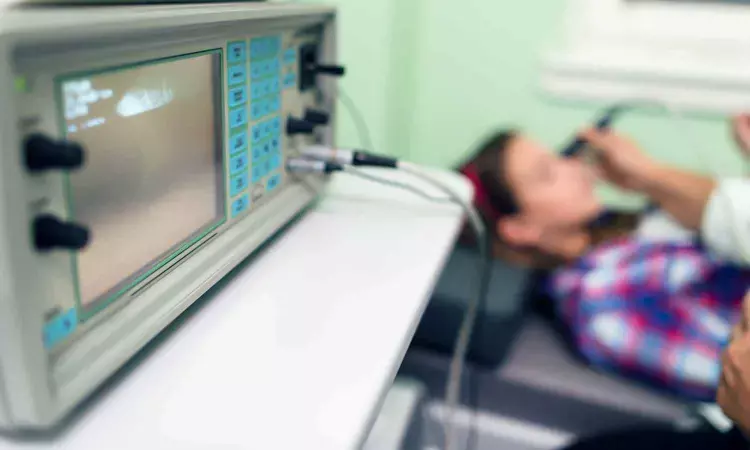- Home
- Medical news & Guidelines
- Anesthesiology
- Cardiology and CTVS
- Critical Care
- Dentistry
- Dermatology
- Diabetes and Endocrinology
- ENT
- Gastroenterology
- Medicine
- Nephrology
- Neurology
- Obstretics-Gynaecology
- Oncology
- Ophthalmology
- Orthopaedics
- Pediatrics-Neonatology
- Psychiatry
- Pulmonology
- Radiology
- Surgery
- Urology
- Laboratory Medicine
- Diet
- Nursing
- Paramedical
- Physiotherapy
- Health news
- Fact Check
- Bone Health Fact Check
- Brain Health Fact Check
- Cancer Related Fact Check
- Child Care Fact Check
- Dental and oral health fact check
- Diabetes and metabolic health fact check
- Diet and Nutrition Fact Check
- Eye and ENT Care Fact Check
- Fitness fact check
- Gut health fact check
- Heart health fact check
- Kidney health fact check
- Medical education fact check
- Men's health fact check
- Respiratory fact check
- Skin and hair care fact check
- Vaccine and Immunization fact check
- Women's health fact check
- AYUSH
- State News
- Andaman and Nicobar Islands
- Andhra Pradesh
- Arunachal Pradesh
- Assam
- Bihar
- Chandigarh
- Chattisgarh
- Dadra and Nagar Haveli
- Daman and Diu
- Delhi
- Goa
- Gujarat
- Haryana
- Himachal Pradesh
- Jammu & Kashmir
- Jharkhand
- Karnataka
- Kerala
- Ladakh
- Lakshadweep
- Madhya Pradesh
- Maharashtra
- Manipur
- Meghalaya
- Mizoram
- Nagaland
- Odisha
- Puducherry
- Punjab
- Rajasthan
- Sikkim
- Tamil Nadu
- Telangana
- Tripura
- Uttar Pradesh
- Uttrakhand
- West Bengal
- Medical Education
- Industry
Long-Term Risk of Cataracts Higher in Pediatric Uveitis Patients: JAMA

A new study published in the Journal of American Medical Association found an increased incidence of cataracts in pediatric patients with uveitis when compared to pediatric patients without uveitis.
Uveitis is one of the most frequent ophthalmologic disorders affecting children's eyes and increases the risk of cataract development. Other variables that may increase the risk of cataract development include the use of steroid eye drops and other immunosuppressive drugs often administered for uveitis. While the specific processes are uncertain, several animal models have revealed that immunosuppressive drugs might negatively influence the proliferation of lens epithelial cells by potentially contributing to cataract formation. To address these information gap in pediatric population, Alan Hsu and colleagues undertook this research on young patients with uveitis to determine the risk of cataract development.
This cohort research included pediatric patients with and without uveitis in the multinational TriNetX database from January 1, 2002 to December 31, 2022. Utilizing diagnostic codes, this study identified a total of 22,687 pediatric patients with uveitis and an equal number of control patients without uveitis. These groups were meticulously matched for age, sex, race, ethnicity and specific comorbidities to ensure robust comparisons. The average age of the participants was 10.3 years with a roughly equal distribution of males and females.
The key findings of this study were:
The primary outcome measure was the hazard ratio (HR) for developing cataracts when comparing the uveitis group to the non-uveitis group.
The results showed that pediatric patients with uveitis had a significantly increased risk of developing cataracts over a follow-up period of up to 20 years. The overall hazard ratio was 17.17 that indicated a more than 17-fold increase in risk for the children with uveitis.
Subgroup studies found an increased cataract risk in all age groups: 0 to 6 years, 7 to 12 years and 13 to 18 years. Both male and female patients with uveitis showed a significantly higher risk of cataracts. Also, the outcomes found increased risks across different racial groups (Asian, Black or African American and White races).
The children who had or did not have a history of immunosuppressive drugs, steroid eye drop usage or intraocular surgeries were more likely to develop cataracts. Overall, this study discovered that patients under the age of 18 with uveitis may have a considerably increased risk of developing cataracts. These findings imply that juvenile patients with uveitis should be closely watched for the development of cataracts.
Reference:
Hsu, A. Y., Kuo, H.-T., Lin, C.-J., Hsia, N.-Y., Kuo, S.-C., Wei, C.-C., Lai, C.-T., Chen, H.-S., Wang, Y.-H., Wei, J. C.-C., & Tsai, Y.-Y. (2024). Cataract Development Among Pediatric Patients With Uveitis. In JAMA Network Open (Vol. 7, Issue 7, p. e2419366). American Medical Association (AMA). https://doi.org/10.1001/jamanetworkopen.2024.19366
Neuroscience Masters graduate
Jacinthlyn Sylvia, a Neuroscience Master's graduate from Chennai has worked extensively in deciphering the neurobiology of cognition and motor control in aging. She also has spread-out exposure to Neurosurgery from her Bachelor’s. She is currently involved in active Neuro-Oncology research. She is an upcoming neuroscientist with a fiery passion for writing. Her news cover at Medical Dialogues feature recent discoveries and updates from the healthcare and biomedical research fields. She can be reached at editorial@medicaldialogues.in
Dr Kamal Kant Kohli-MBBS, DTCD- a chest specialist with more than 30 years of practice and a flair for writing clinical articles, Dr Kamal Kant Kohli joined Medical Dialogues as a Chief Editor of Medical News. Besides writing articles, as an editor, he proofreads and verifies all the medical content published on Medical Dialogues including those coming from journals, studies,medical conferences,guidelines etc. Email: drkohli@medicaldialogues.in. Contact no. 011-43720751


